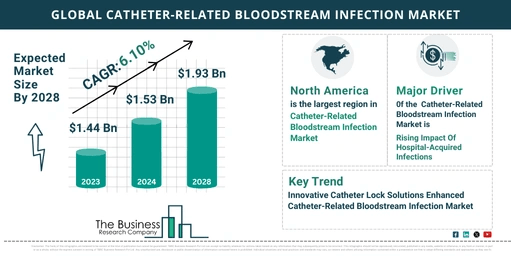Catheter-Related Bloodstream Infection Market Growth Analysis Till 2033 By The Business Research Company
The Business Research Company’s market reports offer an in-depth analysis on the market’s growth potential, major drivers, key trends and more.
The catheter-related bloodstream infection (CRBSI) market has seen significant growth over recent years, reflecting a broader shift in healthcare priorities and innovations. This market is poised for continued expansion, driven by several key factors, including the rising incidence of chronic diseases, the aging population, and the need for enhanced infection control measures.
Current Market Overview
- Market Growth: In 2023, the CRBSI market reached a size of $1.44 billion. It is expected to grow to $1.53 billion in 2024, representing a compound annual growth rate (CAGR) of 5.9%.
- Key Drivers:
- Rising Incidence of Chronic Diseases: More people are living with chronic conditions requiring long-term catheter use, increasing the risk of CRBSIs.
- Increased Awareness and Education: Healthcare providers and patients are becoming more aware of the risks associated with catheter use, leading to better prevention and management practices.
- Aging Population: The growing elderly population, more susceptible to infections, is driving demand for advanced infection control measures.
Future Market Projections
- Market Growth: The CRBSI market is expected to grow from $1.53 billion in 2024 to $1.93 billion in 2028, at a CAGR of 6.1%.
- Key Drivers:
- Healthcare-Associated Infections (HAIs): The rising incidence of HAIs, including CRBSIs, continues to propel market growth.
- Expanded Healthcare Infrastructure: Increased investment in healthcare facilities, particularly in emerging markets, is boosting demand for infection control solutions.
- Supportive Government Policies: Governments worldwide are implementing policies and initiatives to combat HAIs, further driving market growth.
Read More On The Catheter-Related Bloodstream Infection Market Report 2024 – https://www.thebusinessresearchcompany.com/report/catheter-related-bloodstream-infection-global-market-report
Impact of Hospital-Acquired Infections
- Rising Prevalence of HAIs: HAIs, including CRBSIs, are a significant concern in healthcare settings. The global healthcare-associated infection rate was reported at 0.14% in January 2023, with an annual increase of 0.06%.
- Contributing Factors:
- Antimicrobial Resistance: Resistance to common antimicrobial agents makes infections harder to treat, increasing the risk of complications.
- Inadequate Infection Control: Gaps in infection control measures contribute to the spread of HAIs.
- Patient Susceptibility: Patients with indwelling catheters, especially those who are elderly or immunocompromised, are particularly vulnerable to CRBSIs.
Innovations Driving the Market
- Biomaterial Innovations: The development of new materials for catheters that are less prone to microbial colonization is a significant trend.
- Smart Catheter Technology: Integration of technology to monitor and reduce infection risks is becoming more common.
- Advanced Catheter Lock Solutions: Companies are developing catheter lock solutions with antimicrobial properties to reduce infection rates. For example, CorMedix Inc.’s DefenCath received FDA approval in November 2023 as a catheter lock solution combining taurolidine and heparin to combat CRBSIs.
- Improved Sterilization Processes: Innovations in sterilization techniques are helping to lower infection risks.
- Automated Flushing Systems: These systems ensure that catheters remain free of blockages and contamination, reducing the risk of infection.
Strategic Partnerships and Collaborations
- CEMMA Medical and LipoCoat BV Partnership: In April 2022, CEMMA Medical partnered with LipoCoat BV to develop a coated central venous catheter (CVC) aimed at sustainable infection control. This collaboration highlights the industry’s focus on innovative solutions to address the global challenge of HAIs.
Market Segmentation
- By Treatment: The market is segmented into antibiotic lock therapy and antimicrobial agents.
- By Source of Infection: Major causative agents include Staphylococcus aureus, Acinetobacter baumannii, Escherichia coli (E. coli), Klebsiella pneumoniae (K. pneumonia), Candida species, and Pseudomonas aeruginosa.
- By Distribution Channel: The market is divided into hospital pharmacies, retail pharmacies, and online pharmacies.
Regional Insights
- North America: As of 2023, North America held the largest share of the CRBSI market, driven by advanced healthcare infrastructure, strong R&D investment, and a high prevalence of chronic diseases.
Conclusion
The catheter-related bloodstream infection market is on a strong growth trajectory, driven by rising awareness, technological innovations, and the increasing prevalence of hospital-acquired infections. With continued advancements in catheter technology and infection control measures, the market is expected to expand significantly over the next few years, offering promising opportunities for healthcare providers and companies alike.
Request for A Sample Of The Global Catheter-Related Bloodstream Infection Market Report:
https://www.thebusinessresearchcompany.com/sample_request?id=16646&type=smp



